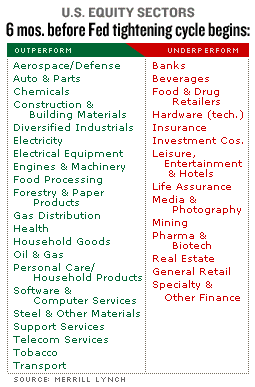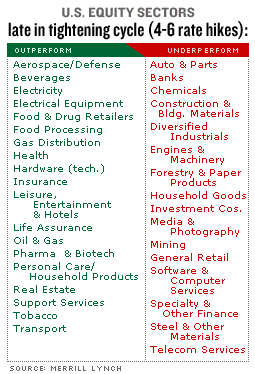NEW YORK (CNN/Money) -
Despite investor moans and groans that come when the Fed raises interest rates ... as it's probably about to do ... there are stocks that manage to do well.
The trick is finding them.
In recent research note, one Wall Street firm, Merrill Lynch, took a stab at doing just that.
Merrill's economists studied sector performance during the past four Fed rate-hiking campaigns, going back to the mid-1980s, and found that some sectors consistently succeeded during Fed party-pooping campaigns, while others consistently disappointed.

Though their research is in no way meant to be a prediction, any such analysis is probably worth a look at this point. After all, barring some unforeseen economic disaster, the Fed's next move is almost certainly a rate increase, as it signaled on Tuesday.
In the past four rate-hiking campaigns, the winning sectors, Merrill said, have been metals, energy, computers and software, tech hardware, electrical equipment, pharmaceuticals, gas utilities, tobacco and food processing.
The consistent losers, according to this research, have been banks, investment firms, real estate, telecom services, construction and building materials, food and drug retailers, beverages, media, leisure and hospitality, and general retailers.
Another generalization: the consumer sector seems to be more interest-rate sensitive than the business sector. That news will probably elicit a big "duh" from many readers, especially economists, who have predicted a consumer slowdown this year.
The economy, which has been carried through its recent struggles by the mighty U.S. consumer, may soon have to rely on business spending to keep growing. If that is so, then sectors making the stuff that businesses buy would seem to be in for a good year.

But the Merrill analysts pointed out that Fed rate-hike campaigns also seem to come in three distinct phases, affecting various sectors in different ways. We could already be in the first phase, the six-month run-up to tightening, a period of growing market anxiety about the apocalypse to come.
Then there's the early phase of tightening, in which things suddenly don't seem so bad; some might call this denial. Finally, there's the later phase, after the Fed has made four or more hikes, sort of a nuclear winter in which only the most defensive stocks are thriving.
Of course, just as every business cycle is unique, so is every rate-hiking campaign. Generalizations such as these should be taken with a liberal dose of salt. Merrill warned that trying to time your moves into and out of various sectors could be a dodgy enterprise, at best.
"Market timing, if not near impossible, is incredibly difficult even for the more talented among us," Merrill's note said.
Nevertheless, it's worth a look at how various sectors have responded to rate increases in recent history.
The prelude (6 months before the first hike)
This is the everybody-panic-about-a-rate-hike phase, and we could very well be in the middle of it right now. According to Merrill's research, the higher commodity prices giving the bond market the willies about inflation have also boosted materials sectors such as metals, oil and gas, chemicals and forest products.

Meanwhile, stocks in interest-rate-sensitive sectors such as finance and real estate have suffered from the fear of rising rates.
But the economy was also hot or overheating in this phase, meaning typical defensive sectors pharmaceuticals, beverages and food and drug retailers have also underperformed.
"Keep in mind that the lead-up to the Fed tightening is not generally a very good time to be fully invested in the market," the note said. "On average, the equity market is down 1.5 percent in the six-month run-up to the first rate hike."
Still, there are several sectors that have outperformed the market during this time in recent decades, including aerospace and defense, autos and parts, health care and transport.
The early stage (1 to 3 rate hikes into the campaign)
Somewhat surprisingly, things often start to look better for the economy and markets during the first phase of a tightening campaign. In the early stages of the past four rate-hike cycles, the S&P 500 actually gained an average of 2.4 percent, according to Merrill's research.
Meanwhile, inflation has translated into better pricing power -- and profits -- for some consumer discretionary sectors, including retail and hotels.
Though real estate has typically continued to be a market laggard during this phase, it's possible that the end of low rates could send a flood of last-minute home-buyers and refinancers into the market for one last bite at the low-rate apple this time around. Auto sales could enjoy a similar boost, as they have in the past.
Nevertheless, several sectors have underperformed in this phase, according to Merrill's research, including banks, beverages, construction, insurance, real estate and even tobacco.
The late stage (4 to 6 rate hikes into the campaign)
The stock gains from the early stage have begun deteriorate. Perversely, real estate stocks have outperformed the broader market during this phase, possibly because they'd previously fallen so far.
Some business equipment has also done well during this phase, including tech hardware and electrical equipment, though computer software underperforms.
For the most part, though, investors hunker down, rotating into the most defensive stocks.
"Bottom line -- no sense monkeying around after the Fed moves on from the fourth to the sixth rate hike," Merrill's note said. "Tobacco, pharma, insurance, food processors, food and drug retailing, beverage producers are all good places to be, from a relative and absolute return standpoint."

Note: this is an updated version of a story that first ran on Apr. 28.
|

